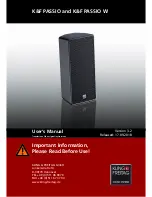
3
Introduction
The MH-1075C-F system provides the mid, and high-frequency components of a DCS 3-way loudspeaker system. It is designed specifically for large
format cinemas and other applications where a point source surround channel or screen channel must be suspended or flown rather than mounted
on a platform or floor.
The high frequency horn is a low-distortion waveguide providing highly articulate dialogue without the coloration associated with conventional horn
loudspeakers. Both horns feature broad horizontal and vertical coverage to ensure audio integrity is delivered to every seat in the auditorium.
The horn and driver assemblies are mounted in a rugged, tour-grade plywood enclosure designed for safe suspension via M10 attachment points.
Heavily braced, tour grade construction provides great strength while keeping weight to a minimum. The rear panel is removable for access to the
drivers and MF/HF crossover if service should ever be necessary.
The MH-1075C-F includes a driver protection and mid-/high-frequency crossover network to assure reliable operation. DC blocking capacitors
protect against DC or low-frequency signals that could damage an unprotected driver. A 12 dB per octave crossover seamlessly blends the mid and
high frequency elements and allows operation in bi-amp mode. Outboard processing, such as the DCP or DCM, is required to provide the active
crossover between the low- and mid-/high-frequency drivers and two separate amplifier channels are required for the normal bi-amp operation of the
SC-423C-F System.
The MH-1075C-F is pre-assembled to reduce field assembly time. Sixteen M10 attachment points provide safe and secure means to suspend the
enclosure via M10 forged eyebolts (not included) or user-supplied brackets.
Suspension
The MH-1075C-F comes with 16 M10 attachment points and bolts installed on the enclosure. Only remove the required bolts for mounting and leave
all other bolts installed to insure that the enclosure retains full strength. We recommend the use of serviceable thread locking compound when
installing the bolts to prevent loosening due to vibration. Use only load rated hardware.
The LF-4215-F, LF-4215-8F, MHV-1090-F and MH-1075C-F have the exact same external dimensions and attachment points. They can be supported
individually or as a group, depending on what works best for the application. The boxes can be arrayed vertically and horizontally. When paired
together, it is recommended that the mounting structure connects both boxes to the suspension system rather than suspending the boxes from one
another. Commercially available uni-strut or other custom fabricated brackets can be used.
Suspending the system from the top rear attachment points results in a slight down angle that may be close to the desired aiming for many
installations. The bottom attachment points can be used for a pull-back cable to fine tune the tilt of the system.
Before placing, installing, rigging, or suspending any speaker product inspect all hardware, suspension, cabinets, transducers, brackets and associated
equipment for damage. Any missing, corroded, deformed, or non-load rated component could significantly reduce the strength of the installation or
placement. Any such condition severely reduces the safety of the installation and should be immediately corrected. Use only hardware which is rated
for the loading conditions of the installation and any possible short-term, unexpected overloading.
Never exceed the rating of the hardware or equipment.
Consult a licensed, professional engineer regarding physical equipment installation. Ensure that all local, state and national regulations regarding the
safety and operation of loudspeakers and related equipment are understood and adhered to.
ARNINNG!:
Ensure all attachment points are installed and correctly tightened in order to maintain enclosure’s rated strength.
Additionally, air leaks resulting from missing hardware will degrade the loudspeaker’s performance. Use only QSC’s M10 forged
shoulder eye bolts. Contact QSC Technical Services department for complete information.
Aiming
The aiming axis of the HF and MF horns is tilted down 10 degrees relative to the cabinet and this should be taken into account when adjusting
the coverage in the room. In general, the aiming axis of the horns should be directed at the prime seating area 2/3 of the way back or across the
auditorium. Slight adjustments may be needed to achieve the best possible compromise when covering the near and far seating area.
























